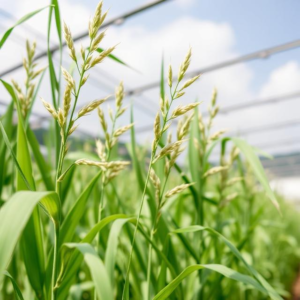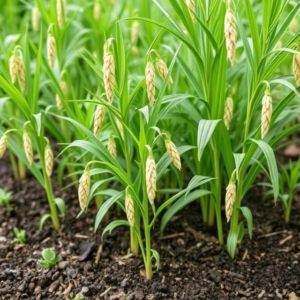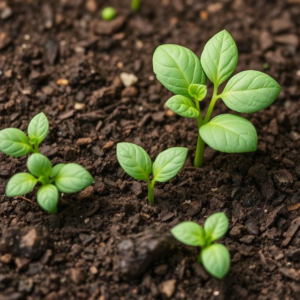Essential Sesame Seed Plant Care Tips for Healthy Growth
Sesame seed plants (Sesamum indicum) are a rewarding and nutritious crop to grow, whether indoors or outdoors. Known for their hardy nature and nutritional benefits, sesame plants are an excellent addition to your garden or home. In this guide, we’ll cover the essential sesame seed plant care tips to help you grow a healthy and productive crop. From planting sesame seed plants to harvesting sesame seeds, we’ve got you covered with step-by-step advice for growing your sesame seeds with success!
1. Understanding the Sesame Seed Plant
Before starting your sesame seed plant care journey, it’s crucial to understand the plant itself. Sesame plants are native to tropical and subtropical regions and thrive in hot, sunny climates.
What is a Sesame Seed Plant?
Sesame is an ancient crop grown for its edible seeds, which are high in healthy fats, protein, and minerals. These plants are typically annuals, completing their life cycle in a single season. They can grow up to 4–5 feet tall and have beautiful bell-shaped flowers.

Ideal Growing Conditions for Sesame Plants
To achieve healthy sesame plants, create an environment that mimics their native habitat:
- Warm temperatures between 75°F and 95°F (24°C – 35°C).
- Full sunlight exposure for at least 6 hours a day.
- Well-draining, slightly acidic to neutral soil (pH 6.0–7.0).
2. Planting Sesame Seed Plants: A Step-by-Step Guide
Successfully planting sesame seeds is the first step toward growing healthy plants. Here’s how you can get started:
Best Time to Plant Sesame Seeds
The ideal planting time is in the spring, after the last frost date has passed. Sesame seed plants need warm soil and air temperatures to germinate properly. It’s essential to plant when daytime temperatures are consistently above 75°F (24°C).
Choosing the Right Location for Sesame Plants
Sesame plants need a lot of sunlight, so choose a spot that gets at least 6-8 hours of direct sunlight every day. Whether growing indoors or outdoors, ensure your plant has enough light for optimal growth.
Outdoor Planting
If you’re planting outdoors, ensure the location has well-drained soil, and there’s enough space for the plants to grow freely. Space sesame seeds about 6 inches apart to allow proper growth.
Indoor Planting
Indoor sesame plants can be grown in large containers. Use pots with good drainage, and supplement with grow lights if natural sunlight is insufficient.
3. Watering and Irrigation: How to Keep Your Sesame Plants Hydrated
Sesame plants are drought-tolerant once established, but they need regular watering during early growth. Here’s how to water sesame plants correctly:
Watering Frequency for Sesame Seed Plants
- Early Growth: Water your sesame plants regularly to keep the soil moist but not soggy.
- Mature Plants: After the plant is established, water deeply every week or two, depending on the climate and soil moisture.

Irrigation Techniques
Consider using a drip irrigation system to target the plant roots directly. This helps maintain moisture in the soil and reduces the risk of fungal diseases. Alternatively, water manually with a gentle stream to avoid disturbing the soil.
4. Light and Temperature: Ensuring the Right Conditions for Healthy Growth
Sesame plants are very sensitive to light and temperature. Follow these guidelines to keep your plants happy and healthy:
Sunlight Requirements
Sesame seed plants need full sunlight for at least 6–8 hours each day. Insufficient sunlight leads to leggy plants and poor seed production. Ensure your sesame plants receive enough exposure to sunlight, especially in the early stages of growth.
Temperature Requirements
Sesame plants thrive in warm conditions with temperatures between 75°F and 95°F (24°C to 35°C). They do not tolerate frost and are sensitive to cold weather. If growing indoors, keep the temperature between 70°F and 80°F (21°C – 27°C).
5. Fertilization and Soil Care for Optimal Growth
Fertilizing your sesame plants correctly will help promote healthy growth and increase seed production. Here’s how to nourish your plants:
Choosing the Right Fertilizer
- Organic Fertilizers: Use compost or well-rotted manure to enrich the soil. These provide essential nutrients without chemical additives.
- Synthetic Fertilizers: If using synthetic fertilizers, choose a balanced formula like 10-10-10 (Nitrogen-Phosphorus-Potassium) for overall plant health.

How Often to Fertilize Sesame Plants
Fertilize sesame plants once a month during the growing season. If your soil is nutrient-deficient, you can increase the frequency of fertilization to every 2–3 weeks.
Soil pH and Quality
Sesame plants prefer slightly acidic to neutral soil with a pH range of 6.0-7.0. Test the soil pH before planting and amend it as necessary. Improving soil quality with compost or organic matter will encourage healthy root growth and strong plants.
6. Pruning and Maintaining Healthy Sesame Plants
Pruning is essential to keep your sesame seed plants healthy and prevent overcrowding. Here’s what you need to do:
When to Prune Your Sesame Plant
- Remove Dead or Damaged Leaves: Regularly remove any yellowing or diseased leaves to improve air circulation and plant health.
- Prune Excess Growth: If your sesame plant is growing too densely, prune back some of the branches to promote better airflow.
Maintaining Healthy Growth
- Pest Control: Check for pests like aphids, whiteflies, or caterpillars. Treat infestations with organic pesticides or neem oil.
- Disease Prevention: Prevent fungal diseases like powdery mildew by ensuring proper spacing between plants and keeping the area free of debris.
7. Harvesting Sesame Seeds: The Right Time and Techniques
Knowing when and how to harvest sesame seeds is crucial for obtaining the highest-quality crop.
When to Harvest Sesame Seeds
Sesame seeds are ready for harvest when the pods turn yellow or brown and dry out. Gently press the pods to ensure the seeds are fully developed and firm. Harvesting too early may result in underdeveloped seeds.
Harvesting Technique
- Cut the Plants: Once the pods are fully dry, cut the sesame plants near the base.
- Dry the Pods: Hang the plants upside down in a cool, dry, and well-ventilated area.
- Extract the Seeds: After drying, extract the seeds by gently shaking or crushing the pods.
Storing Sesame Seeds
Once harvested, store sesame seeds in an airtight container in a cool, dry place. Proper storage ensures the seeds remain fresh and viable for future planting or use in cooking.
8. Common Problems with Sesame Seed Plants and How to Solve Them
Despite their hardiness, sesame plants can face a few issues. Here’s how to tackle common problems:
Pests
Common pests like aphids, whiteflies, and caterpillars can damage sesame plants. Use natural insecticidal soaps or neem oil to treat infestations. Additionally, regularly check your plants for pests and remove them manually if possible.
Diseases
Fungal diseases such as powdery mildew can affect sesame seed plants, especially in humid conditions. To prevent this, ensure proper spacing between plants, use well-draining soil, and avoid overhead watering.
Poor Seed Production
If your sesame plants are not producing seeds, it could be due to inadequate sunlight, insufficient water, or nutrient imbalances. Ensure your sesame plants receive at least 6–8 hours of sunlight and maintain a consistent watering schedule. Fertilize as needed and monitor plant health closely.
Conclusion: Grow Healthy Sesame Seed Plants with Confidence
By following these essential sesame seed plant care tips, you’ll be well on your way to growing healthy and productive sesame plants. Proper planting, watering, light, and soil care are key to ensuring a successful crop. With these guidelines in mind, your sesame plants will flourish and provide you with fresh, homegrown seeds for culinary use or replanting in future seasons.
Gardening with sesame seed plants can be a rewarding and fun experience. By ensuring optimal growing conditions, managing pests, and harvesting at the right time, you’ll enjoy a bountiful sesame harvest. Happy planting!
More Post
dzrlqe
24jyr7